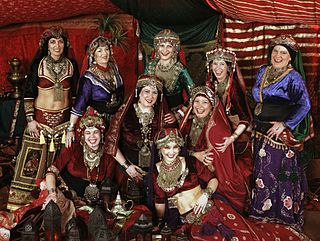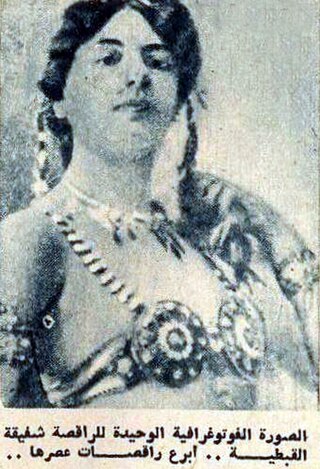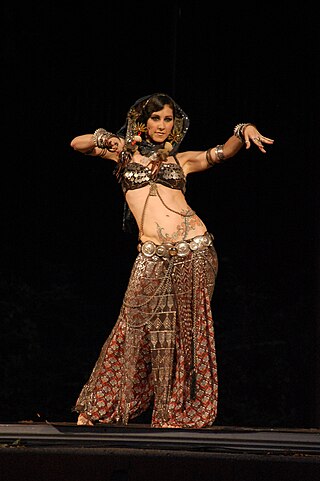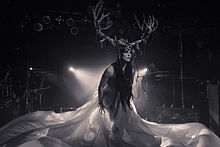
Ballet is a type of performance dance that originated during the Italian Renaissance in the fifteenth century and later developed into a concert dance form in France and Russia. It has since become a widespread and highly technical form of dance with its own vocabulary. Ballet has been influential globally and has defined the foundational techniques which are used in many other dance genres and cultures. Various schools around the world have incorporated their own cultures. As a result, ballet has evolved in distinct ways.
Dance improvisation is the process of spontaneously creating movement. Development of movement material is facilitated through a variety of creative explorations including body mapping through levels, shape and dynamics schema.

Mardi Gras Indians are African American carnival revelers in New Orleans, Louisiana, who dress up for Mardi Gras in suits influenced by the cultural practices of Native Americans, West Africans, and Afro-Caribbeans. The music, dance, and regalia from these cultures created the Mardi Gras Indian tradition during the era of slavery in Louisiana that continues today. This cultural tradition is a part of the African and African diaspora decorative aesthetic, and is an African-American art form. Black masking Indians are a subculture in New Orleans.
Balkan music is a type of music found in the Balkan region of southeastern Europe. The music is characterised by complex rhythm. Famous bands in Balkan music include Taraf de Haïdouks, Fanfare Ciocărlia, and No Smoking Orchestra.

Dance in India comprises numerous styles of dances, generally classified as classical or folk. As with other aspects of Indian culture, different forms of dances originated in different parts of India, developed according to the local traditions and also imbibed elements from other parts of the country.

Carolena Nericcio started the Fat Chance Belly Dance troupe, formerly American Tribal. FCBD/ATS developed a unique style of belly dance known simply as the FCBD style, of which the primary defining characteristic is group improvisation. It is generally performed at community events such as festivals and parades, with dancers typically favoring a look provided by wide-legged pants gathered at the ankles, tops known as cholis and full skirts.

Ghawazi are female dancers who danced in return for money in public settings, and the streets. There were male dancers as well, including men who performed movements associated with women and who were pejoratively called khawal.

Rachel Brice is an American professional belly dancer in Tribal Fusion style belly dance based in Portland, Oregon. She is the artistic director and choreographer for The Indigo Belly Dance Company and a frequent performer with the Bellydance Superstars. In June 2011 she opened her own dance studio in Portland, Oregon, called Studio Datura. There she hosts regular dance classes along with workshops from her 8 Elements™ Approach to Belly Dance training program.

The Indigo Belly Dance Company is a tribal fusion style belly dance company that was based in San Francisco. It was founded by Rachel Brice in 2003. Its members include Brice, Mardi Love, and Zoe Jakes. Past members include Sharon Kihara, Ariellah Aflalo, Janice Solimeno, and Michelle Campbell. Many of these dancers currently teach and perform internationally, and have also appeared with Bellydance Superstars.

Gothic belly dance, also named and separated in substyles as Gothic fusion belly dance, dark fusion belly dance and Gothic tribal fusion, is a recently founded dance art movement, distilled from the influences of Middle Eastern dance, tribal fusion, goth subculture and neopaganism. Originating in the United States in the 1990s, it has spread to be practiced by amateur and professional dancers around the world, and it is growing with the spread of tribal belly dance formats.
Improvisational Team Synchronization, Improv Team Sync, or ITS belly dance is a style of group dance improvisation, often associated with Tribal Fusion and belly dance. ITS is performed by a group of dancers consisting of one of more leaders and followers. The dance relies on a shared vocabulary of movements, each initiated by the leader using a distinct cue movement. After the cue, a short choreographed movement sequence, or combo, is performed by the group. The leader chooses the combo based on their interpretation of the music, which is often done spontaneously during the performance. The result is a dance that appears choreographed, but is in fact structured improvisation. This format of structured group improvisation was first developed by Carolena Nericcio-Bohlman, the founder of American Tribal Style.

Acro dance is a style of dance that combines classical dance technique with acrobatic elements. It is defined by its athletic character, its unique choreography, which blends dance and acrobatics, and its use of acrobatics in a dance context. It is a popular dance style in amateur competitive dance as well as in professional dance theater and in contemporary circus productions such as those by Cirque du Soleil. This is in contrast to acrobatic, artistic and rhythmic gymnastics, which are sports that employ dance elements in a gymnastics context under the auspices of a governing gymnastics organization and subject to a Code of Points. Acro dance is known by various other names including acrobatic dance and gymnastic dance, though it is most commonly referred to simply as acro by dancers and dance professionals.

Beats Antique is a U.S.-based experimental world fusion and electronic music group. Formed in 2007 in conjunction with producer Miles Copeland, the group has become noted for their mix of different genres as well as their live shows, which mix samples and heavy percussives with Tribal Fusion dance and performance art.

Belly dance is a Middle Eastern dance that originated in Egypt, which features movements of the hips and torso. A Western-coined exonym, it is also referred to as Middle Eastern dance or Arabic dance. It has evolved to take many different forms depending on the country and region, both in costume and dance style; with the styles and costumes of Egypt being the most recognized worldwide due to Egyptian cinema. Belly dancing in its various forms and styles is popular across the globe where it is taught by a multitude of schools of dance.
Project X Presents was a collaborative arts network based in Birmingham, England, active from around 2004 to 2009. The group produced a series of themed performance events in the city which they christened "omnimedia experiences".
The following are the special concepts and terminology of belly dance. As this dance has many forms and can be found in North Africa and the Middle East, a significant proportion of the terminology is in Arabic. Turkish or Turkish-loan words may also be encountered among belly dance terms.
Raks Geek is a bellydance, flow arts, and fire performance company based in Chicago, Illinois. They were the first professional group to successfully combine bellydance and firespinning with geek themes in a consistent manner. They are most known for a viral YouTube video featuring a Wookiee bellydancing to a Klingon band playing original music in Shyriiwook, which was listed on UK Channel 4 TV's "50 Funniest Moments of 2012." They are the most well-known example of fusing bellydance with geek themes and are considered one of the top dance companies in Chicago.
In dance, floorwork refers to movements performed on the floor. Floorwork is used extensively in modern dance, particularly Graham technique, Hawkins technique, and breakdancing. Some dance training practices, notably Floor-Barre, consist entirely of floorwork.
World Dance New York is a US home entertainment company, releasing and distributing special interest titles on DVD, video on demand, streaming media, iPhone and iPad apps, and a brand of women's dance and fitness home video products. It was founded in 2001 as "Stratostream - World Dance New York". "Stratostream" designates the company in the business-to-business environment, the home video industry, while "World Dance New York" is the publicly-recognized brand and the name of the consumer-facing operation of the company.

Arab folk dances, also referred to as Oriental dance, Middle-Eastern dance and Eastern dance, are the traditional folk dances of the Arabs in Arab world. Arab dance has many different styles, including the three main types of folklore, classical, and contemporary. It is enjoyed and implemented throughout the Arab region, from North Africa to the Middle East.













